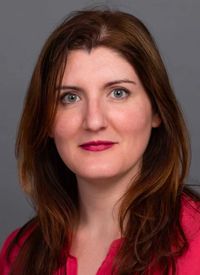Article
Herpes Simplex-1 Oncolytic Showcases Antitumor Activity Across Heavily Pretreated Solid Tumors
Author(s):
November 13, 2020 - The genetically modified herpes simplex-1 oncolytic RP2 demonstrated encouraging clinical activity and an acceptable safety profile in heavily pretreated patients with advanced solid tumors
Francesca Aroldi

November 13, 2020 -The genetically modified herpes simplex-1 (HSV-1) oncolytic RP2 demonstrated encouraging clinical activity and an acceptable safety profile in heavily pretreated patients with advanced solid tumors, according to findings from a phase 1 study (NCT04336241) that were presented during the 2020 SITC Virtual Congress.
Of the 9 patients treated with single agent RP2, 1 patient with esophageal cancer and 1 patient with uveal melanoma had ongoing partial responses at 9 months, and 1 patient with mucoepidermoid carcinoma had an ongoing complete response.
“These data support the hypothesis that anti-CTLA-4 delivered intra-tumorally through oncolytic virus replication, with accompanying antigen release and presentation, can provide potent anti-tumor effects,” wrote Francesca Aroldi, lead study author, and clinical research fellow at the University of Oxford, and co-authors, in the poster presentation.
RP2 is an enhanced potency HSV-1 oncolytic, expressing granulocyte-macrophage colony-stimulating factor (GM-CSF), a fusogenic protein (GALV-GP R-), and an anti-CTLA-4 antibody-like molecule.
The open-label, multicenter,dose-escalation and -expansion study was designed to evaluate the safety and efficacy of RP2 alone and in combination with nivolumab (Opdivo) in patients with advanced solid tumors.
The dose-escalation portion of the study, and focus of the poster presentation, was designed to assess the safety and tolerability of RP2 and establish the recommended phase 2 dose (RP2D) of RP2. The dose-expansion portion of the study will further evaluate the safety of RP2 in combination with nivolumab at the RP2D.
Eligible patients had histologically or cytologically confirmed advanced or metastatic non-neurological solid tumors. Patients had progressed on or could not tolerate standard therapy, or had no standard therapy preferred to enrollment in a clinical trial. Patients also had to have at least 1 measurable and injectable tumor measuring at least 1 cm in longest diameter, adequate hematologic function, and an ECOG performance status (PS) of 0 or 1.
The tumor types represented in the trial consisted of cutaneous melanoma (n = 1; 11.1%), uveal melanoma (n = 3; 33.3%), mucosal melanoma (n = 1; 11.1%), microsatellite stable colorectal adenocarcinoma (n = 1; 11.1%), mucoepidemoid carcinoma (n = 1; 11.1%), squamous cell carcinoma (n = 1; 11.1%), and oesophageal adenocarcinoma (n = 1; 11.1%).
Exclusion criteria comprised prior treatment with an oncolytic therapy and active central nervous system metastases and/or carcinomatous meningitis.
Patients were to treated using a 3 + 3 dose escalation at 2 dose levels of up to 10 mL. RP2 was given every 2 weeks for up to 5 doses. With regard to the first dose level, patients received 105 plaque forming units (PFU)/mL of RP2 followed by 4 doses of 106 PFU/mL; the second dose level consisted of 106 PFU/mL of RP2 followed by 4 doses of 107 PFU/mL.
Between 3 to 6 additional HSV-1 seronegative patients received the RP2D, and a combination cohort of up to 30 patients received up to 8 doses of the RP2D in combination with 240 mg of nivolumab every 2 weeks for 4 months from the second RP2 dose, then 480 mg every 4 weeks for 20 months.
Lesions were injected directly or under imaging guidance used for visceral lesions. Tumor biopsies were collected for biomarker analysis. Viral shedding and anti-HSV antibody titers were also monitored.
The median patient age was 55 years (range, 36-76). The majority of patients were male (n = 8; 88.9%) and had an ECOG PS of 0 (n = 6; 66.7%).
All patients had received prior therapy; 6 had received prior anti–PD-1 therapy (66.7%), 4 had received prior chemotherapy (44.4%), and 3 had received prior radiotherapy (33.3%).
The majority of patients were seropositive (n = 6; 66.7%) vs seronegative (n = 3; 33.3%).
Regarding safety, grade 1 or 2 adverse effects (AEs) occurred in 6 patients (66.7%), and grade 3 AEs occurred in 1 (11.1%). Grade 1 or 2 AEs consisted of pyrexia (n = 6; 66.7%), fatigue (n = 3; 33.3%), hypotension (n = 3; 33.3%), chills (n = 2; 22.2%), hyperhidrosis (n = 1; 11.1%), influenza like symptoms (n = 1; 11.1%), nausea (n = 1; 11.1%), rash (n = 1; 11.1%), vomiting (n = 1; 11.1%), and left groin and thigh pain (n = 1; 11.1%). Grade 3 AEs included cytokine release syndrome (n = 1; 11.1%) and hypocalcemia (n = 1; 11.1%).
No dose-limiting toxicities requiring dose-level expansion were reported (n = 9).
The RP2D was determined to be up to 10 mL of 106 PFU/mL of RP2 followed by multiple doses of 107 PFU/mL every 2 weeks.
“RP2 demonstrated an acceptable safety profile, with most AEs being grade 1/2,” wrote the study authors. “Both direct injection of superficial and nodal tumors, and imaging guided injection of deep/visceral tumors were well tolerated and practical.”
Ten patients have been enrolled into the dose-expansion portion of the trial, with preliminary data indicating that the combination of RP2 and nivolumab is well tolerated.
Reference
Aroldi F, Sacco JJ, Olsson-Brown A, et al. Initial results of a phase 1 trial of RP2, a first in class, enhanced potency, anti-CTLA-4 antibody expressing, oncolytic HSV as single agent and combined with nivolumab in patients with solid tumors. Presented at: SITC Virtual Congress; November 9-14, 2020. Poster: 421.


















%20(2)%201-Recovered-Recovered-Recovered-Recovered-Recovered-Recovered-Recovered-Recovered-Recovered-Recovered-Recovered-Recovered-Recovered-Recovered-Recovered-Recovered-Recovered-Recovered.jpg?fit=crop&auto=format)
%20(2)%201-Recovered-Recovered-Recovered-Recovered-Recovered-Recovered-Recovered-Recovered-Recovered-Recovered-Recovered-Recovered-Recovered-Recovered-Recovered-Recovered-Recovered-Recovered.jpg?fit=crop&auto=format)
